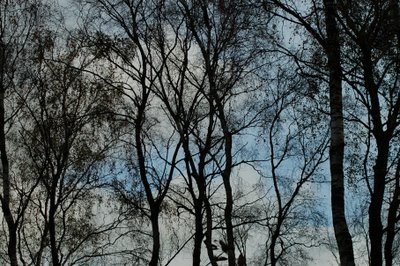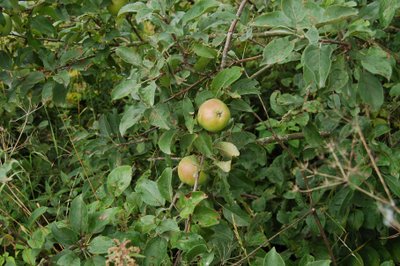* March 12. 1096 + January 7. 1131
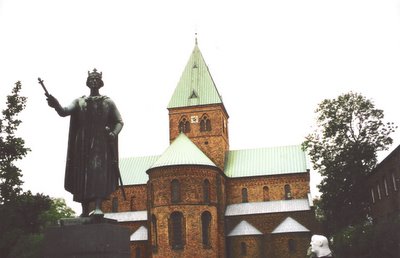
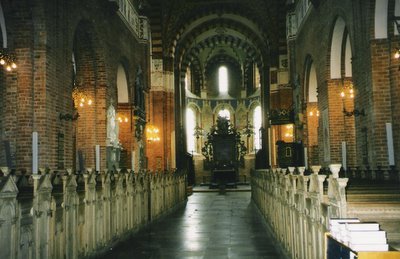
Sct.Bendts Church, Ringsted, Zealand
Knud was a son of Erik 1. Ejegod and Bodil Thrugotsdatter. After his parents' death on a pilgrimage the seven year old Knud was first brought up by the legendary Zealand chief Skjalm Hvide and later by Herzog Lothar of Saxony, who became German king in 1125. Knud was married to Ingeborg of Russia in 1116; she was a daughter of Grossfürst Mstislav 1. of Kiev and Christina of Sweden, and about the same time , when he was about 20 years old, he became Jarl of the border and Hertug of Schleswig. His mission was to protect the merchants and the trade routes against the Wends, which he did so successfully that the merchants appointed him their patron protector. His byname Lavard was a name of honour; the word originated from Old English hlaford = Lord. It meant Lord(Herre) in Saxon and other Germanic languages - the original meaning was bread giver.
In the beginning of the 1100s Henrik Gottskalkssøn, a son of the Abodrit knés Gottskalk, threatened the Danish south border, since king Niels, his mother's brother, would not pay the inheritance after his mother Sigrid, a daughter of Svend Estridssen. Knud Lavard fought for some years several times against Henrik, until a peace was contracted between Danes and Abodrits. After Henrik Gottskalkssøn's death Knud became - with the assistance from king Lothar - Henrik's successor as knés over the Abodrits under Saxon superiority. Knud Lavard was in this way both the Danish and German king's vassal.
As a son of king Erik 1. Ejegod Knud Lavard was an obvious candidate to the Danish throne, also because he had important and friendly contacts to king Lothar and the Wends, but others were more than interested in the royal power. Among those were his cousin Magnus, a son of king Niels - and another cousin, Henrik Skadelaar, a son of Svend, who like Niels and Erik Ejegod was a son of Svend Estridssen. Svend had been desperate for gaining the Danish crown, but he died on 1104 on his way to Viborg Thing. Henrik had inherited his father's dream; he conspired with Magnus against Knud Lavard for years.
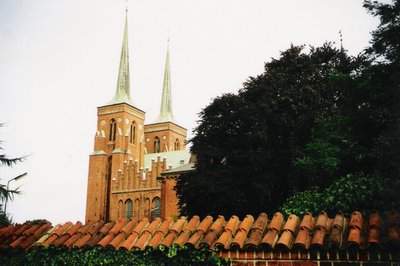
Roskilde Cathedral, ZealandIt all started seemingly peaceful Christmas 1130 in a cosy get-together of the royal family. King Niels, who was about 66 years old, had gathered some of his family in Roskilde. At that point his queen, Margrethe Fredkulla had been gone long ago, it is said she died about 1117. The family members assembled that Christmas might have been Magnus and his wife, Richiza of Poland and their children; Henrik Skadelaar was probably alone, since his wife Ingerid, who was a brother's daughter of Margrethe Fredkulla, had run away with her lover - unless he had brought her back again. The story says he found her in Aalborg. They had three sons.The special Christmas guests were Knud Lavard and his pregnant wife, Ingeborg, and possibly their three daughters, Margrethe, Christina and Cathrine, the eldest was about 13-14 years old. Ingeborg's mother, Christina,was a sister of Margrethe Fredkulla - everyone in these Christmas days were closely related - and yet something sinister went on underneath the surface.
Margrethe was known to be a peacemaker. Her byname Fredkulla meant "The Peace Girl", and while she lived, she had probably enough to do keeping peace among Svend Estridssen's strong willed sons and grandsons. A source says that she had made bad blood between Magnus and Knud Lavard, but it was more plausible Henrik Skadelaar, who intrigued with Magnus against Knud. Henrik was often mentioned as a bitter person, filled with envy and hate against Knud Lavard.Knud was blamed for his royal behaviour and luxurious "foreign" clothes; it was not suitable to outshine the king himself. Maybe it was on this Christmas holiday that Henrik exclaimed that Scarlet clothes would never secure Knud against a sword, to which Knud replied that Henrik was not at all safer in his sheepskins.
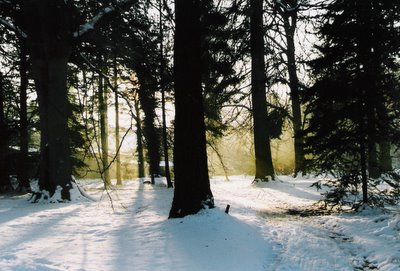
After the visit in Roskilde Knud Lavard and his wife and daughters went to visit another kinsman, a daughter of Knud the Holy, Cæcilia and her husband Erik Jarl on their manor house near Haraldsted Church north of Ringsted. Cæcilia and Erik had strong family ties to the powerful Hvide family, since their daughter Inge was married to Skjalm Hvide's son Asser Rig (Ryg). Inge and Asser had two little sons, Absalon was two and Esbern(Snare) three years old. They didn't know yet, but they would soon become the sworn brothers of Knud and Ingeborg's son Valdemar.
While Knud Lavard and Ingeborg were guests by Cæcilia and Erik Jarl, Magnus summoned Knud for a friendly meeting in Haraldsted Forest on January 7th. Ingeborg was suspicious and tried to persuade her husband not to go, but Knud suspected no foul play. He went off with only a few men and straight into an ambush, in which he was murdered by Magnus and his men on the day after Twelfth Night.
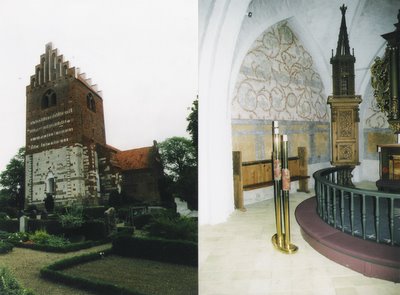
Haraldsted Church, Zealand
It is easy to imagine the horror and grief in Knud Lavard's family. Cæcilia asked - probably on behalf of the shocked Ingeborg - that Knud's body should be brought to Haraldsted Church and buried there, but some days later his coffin was carried to Ringsted. On January 14th, seven days after her husband's murder, Ingeborg gave birth to a son, who was named Valdemar after her grandfather, Grand Prince Vladimir Monomachos of Kijev.
Ingeborg spent probably some time by the family in Haraldsted, and she decided that it would be safest for her son to be brought up in the strong and loyal Hvide family like his father before him. Years later she made another important decision for her son. On September 18th in 1137 king Erik 2. Emune was murdered, and the chief Kristiern Svendsen, a cousin of Knud Lavard and one of the mightiest men in the country, wanted the six year old Valdemar pronounced king of Denmark, but Ingeborg opposed strongly and did not give her consent.
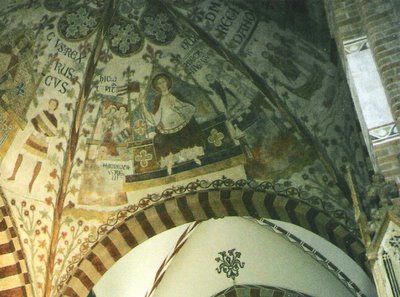
Sct. Bendts Church, Ringsted, Zealand
After Knud Lavard's murder the Zealand chiefs held a thing and forced king Niels to send Magnus in exile. Knud's half brother Erik Emune acted as Knud's avenger and was pronounced king in Skaane. Henrik Skadelaar still worked behind scenes and persuaded king Niels to send for his son again, and it was actually Magnus' return, which started several years of bloody civil war between Niels and Magnus on one side and Erik Emune on the other.
Down south the situation was also tense. The German-Roman emperor Lothar (crowned emperor 1133) wanted revenge for the murder of his vassal. In 1134, during the civil wars, the new pope, Innocens, abolished the independence of the Danish Church and placed it under Hamburg-Bremen again. This caused archbishop Asser to join Erik Emune - and so did the migthy Hvide family.
After years of violent civil wars and various victories and defeats it ended on June 4th 1134 in a battle by Fodevig near Lund in Skaane. The battle was a total defeat for Niels and Magnus. Magnus and Henrik Skadelaar were killed, and Niels fled to Schleswig,where he was recognized and killed by the citizens who wanted to revenge Knud Lavard. Erik Emune came on the throne and started at once the efforts to strenghten his legality by having Knud Lavard sainted.
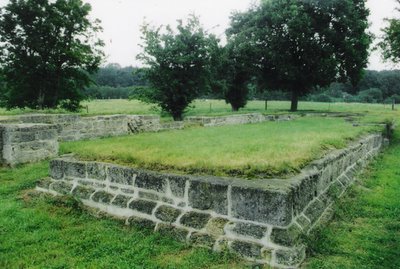
Knud Lavard's chapel, Haraldsted, Zealand
According to tradition a spring welled up where Knud Lavard was murdered - and another spring where the bearers stopped on their way to Ringsted. Soon miracles happened by his grave, and an abbey was founded in 1135 to take care of the grave and help the pious pilgrims, who came to visit. Upon the scene of the murder a chapel was built, which gave good income by pilgrimages.
Finally the Holy See had to acknowledge Knud Lavard as a saint, and in a great ceremony his bones were moved into a glorious shrine upon the high altar of the big - not yet finished abbey church, which later was given the name Sct. Bendts Church. This happened on June 25. 1170, which became Knud Lavard's official Saint's day. At this point Knud's son had gained power long ago. He was crowned sole king in 1157 by the name Valdemar the Great.
photos: grethe bachmann
